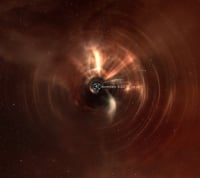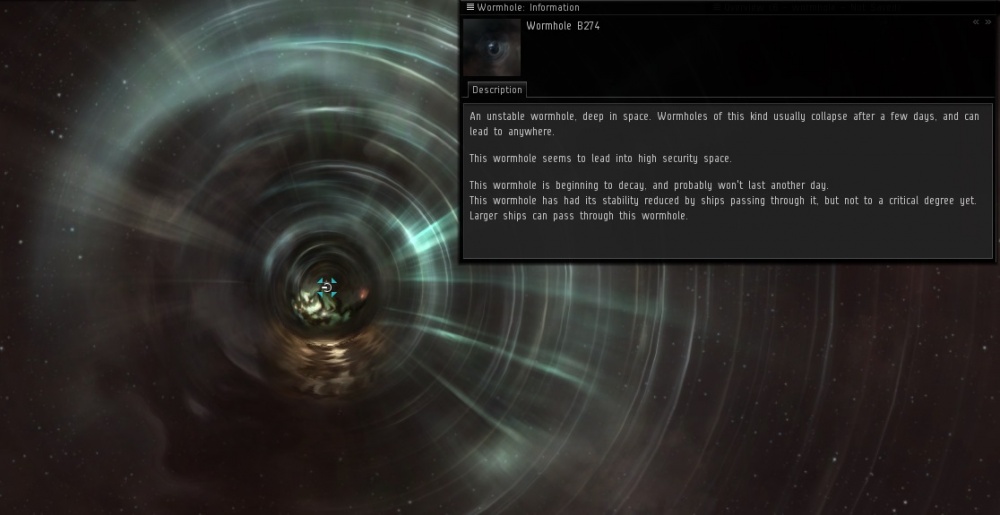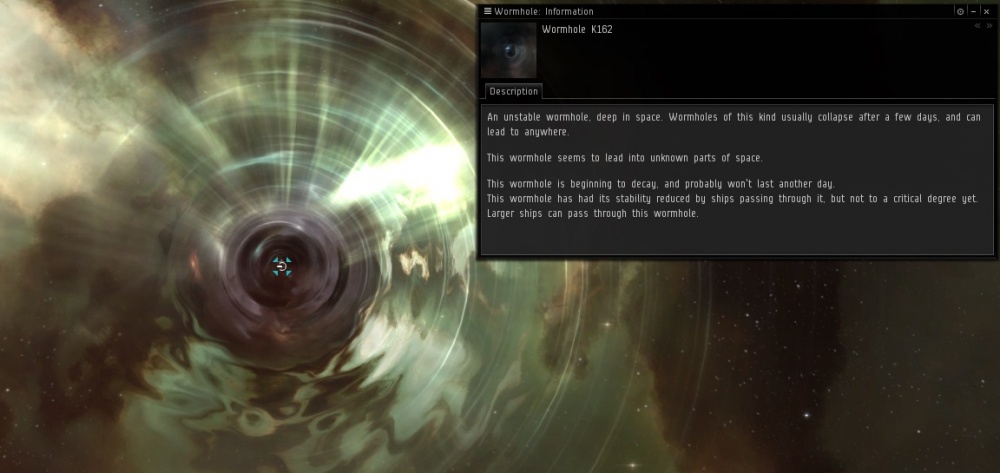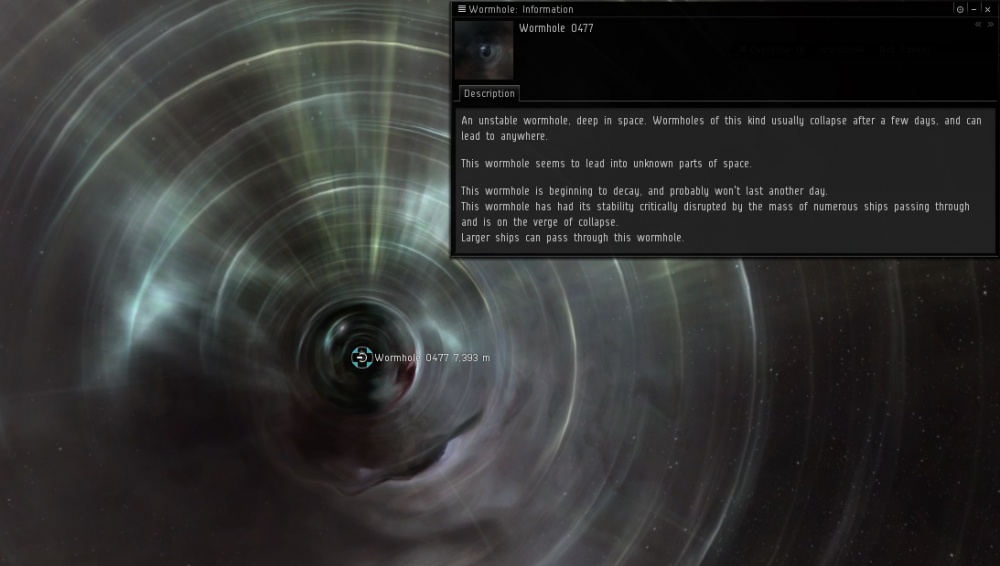Difference between revisions of "Wormholes"
(→Ship Size: Description Text) |
(→Life: Safe return recommendation) |
||
| Line 92: | Line 92: | ||
|'''reaching the end''' ||less than 4 hours||EOL | |'''reaching the end''' ||less than 4 hours||EOL | ||
|} | |} | ||
| + | |||
| + | It is possible there is an indication even shorter than 4 hours known as "dissipating into the ether," although it is unknown exactly how long this lasts. It is therefore not recommended to traverse an end of life wormhole without some alternative method of returning back home, such as a corpmate able to scan down a new entrance. | ||
===Mass=== | ===Mass=== | ||
Revision as of 23:25, 30 April 2019

|
| Wormholes |
|---|
| Life in wormholes |
| EVE University specific |
| Reference |
| NPCs |
| External links |
| EVE University offers classes on: | |
Wormholes, introduced in Apocrypha expansion, are rifts in space that connect two star systems. Like stargates, they allow the travel of ships from one star system to another, but unlike stargates, wormholes are not permanent. They connect two systems for only a short time and collapse when either their lifespan ends or too many ships have passed through them. Wormholes can connect any two systems regardless of distance from each other, providing temporary shortcuts to areas that would otherwise take many jumps to reach. Wormholes can also connect to uncharted space, or the Anoikis galaxy (henceforth referred to as Wormhole Space or W-Space); these systems are uncharted, and do not operate like normal systems.
In the Rhea expansion, new types of wormholes were introduced - the massive wormhole system with stations, Thera, and Shattered Wormholes, mysterious spaces which cannot have any residents. Recently the Drifters have appeared, and with them five Drifter wormhole systems that are marked from known space with a "unidentified wormhole" beacon.
Finding Wormholes
Wormholes can be found by scanning down cosmic signatures. Once a wormhole is probed down, it can be warped to and jumped through much like a stargate, though unlike gates they must be warped to and then jumped through as a two-step process.
You may refer to the Scanning and Exploration guides if you want to learn about finding wormholes.
Destinations
Wormholes lead to many different places - they can connect W-Space to mapped New Eden systems (henceforth referred to as Known Space or K-Space), others connect from K-Space to W-Space, yet others connect W-space to other W-space systems, and some wormholes connect K-space to K-space. Wormholes forming within W-Space provide the sole method for inter-system travel for residents of the wormhole. There are no stargates in W-Space.
Known Space to Known Space Wormholes are used to quickly travel throughout New Eden, they're also used to access high-sec or low-sec islands without risk of travelling through potentially dangerous space. They're commonly named for the sec status on both ends. High-to-high (H2H), low-to-null (L2N), null-to-high (N2H), etc.
Known Space to Wormhole Space Wormholes connect K-Space to W-Space. Players who do exploration use them to access W-Space to run cosmic anomalies and signatures. W-Space inhabitants use them to shop, resupply, sell loot and products and go on K-Space PvP roams. Without these wormholes, W-Space would be a desolate wasteland. Components required to build Strategic Cruisers and their subsystems are available only in W-space.
Since there are no gates available in W-Space systems Wormhole Space to Wormhole Space Wormholes provide the sole means of interstellar transport. Their dynamic formation and dissolution define W-Space interactions, in the form of PvE - capsuleers killing sleeper rats or PvP - capsuleers killing each other. W-Space to W-Space wormholes are very crucial; there are some W-Space systems that rarely get connections to K-Space.
Wormhole Local
There is no automatic update to the “local” chat channel when in w-space, so pilots in w-space will not automatically appear in the local member list like they would in an Empire or a 0.0 space system. This means that there is no indication of who or how many other pilots are in the same w-space system you are in. With a cloak, no one will even know you’re there. If you do type in local chat you will show up in the local member list as normal. It is not advisable to chat in local while in w-space as it reveals your presence in the system.
Note that when you enter a wormhole, there is a visible brightening and a sound effect to indicate that the hole has been activated - so if someone is watching a wormhole, they will know that someone has jumped in.
Wormhole Identification
The color of a wormhole may give you an impression on where it leads. The outline will be the color of your current system and the center will be colored based on where it leads. The color also changes based on the size of the wormhole. See Visual wormhole identification for more details.
Right clicking and showing info on wormhole entrances will also display a description about where they lead and their stability status.
Wormhole Sizes and Restrictions
Wormholes come with different restrictions. Wormholes not only allow certain amounts of mass through them in their lifetime, but they also have mass restrictions for each particular transfer. For example, some wormholes from K-Space to C3 wormhole space will restrict ships going through to destroyers or smaller.
Capital ships with jump drives can go through wormholes, providing the wormhole can support the ship's mass. Cynosural fields can be opened in wormhole space, but ships with jump drives cannot lock on to these fields, nor can they lock on to cynosural fields outside of wormhole space to jump out. Supercapital ships such as Titans and Supercarriers cannot go through wormholes at all, as they are far too large for even the largest wormholes. Capitals can be built in W-space, but they may not be able to take any of exits to K-space or even other W-space connections. Supercapitals cannot be built, as there is no sovereignty in wormhole space.
The color of the flare around a wormhole can tell you the size of ships that can go through. Color Effects for wormholes are described in more detail in Visual wormhole identification.
Polarization
Jumping through wormholes introduces additional restrictions on how often in a given time a pilot may jump through a particular wormhole. You may not jump through a wormhole in the same direction twice within five minutes. For example, if you jump through a wormhole at 05:00 and then jump back through the wormhole at 05:03, you will be polarized until 05:05, five minutes after your last transit in that direction. When polarized the wormhole will prevent you from jumping through, and present you with a message informing you how much time is left on your polarization timer. Similarly, if you were to jump as soon as the timer was up, you would be polarized on the other side of the hole until 05:08, five minutes after your last transit in that direction.
One way to manage your polarization timer is to check local chat for time stamps (multiple wormhole jump time stamps are kept in the chat, unlike gate jumps in k-space) for your jumps and then plan accordingly.
Keep in mind that this restriction applies to the pilot, not the ship or the account. The same ship can be swapped by ejection and boarding by different capsuleers for immediate transit through the same wormhole. This is very useful for mass reduction operations without need for multiple ships of same type. This is, however, a somewhat more dangerous way to roll a wormhole, as multiple pilots jumping from ship to ship are at least momentarily extremely vulnerable.
Aggression
Weapon timers do not apply in wormhole spaces. You still get them when you aggress capsuleers, but they don't have any effect other than delaying your disappearance from space when you log off. As long as you are not polarized you can jump through a wormhole immediately after aggressing any capsuleer in any manner. There is no CONCORD in W-Space, no stargate sentry guns, and commonly no stations. For this reason many battles in W-Space take place very near wormholes. This can provide escape options even if you are webbed, scrammed, or bubbled.
Wormhole Text
When on grid with a wormhole entrance, right click on the entrance and click on show info. This will give you information about the wormhole. There are 4 sentences in the information.
System Type
The first sentence talks about the type of the wormhole. These will be of the following format:
- This wormhole seems to lead into {important part} parts of space.
| Text | Meaning |
| Unknown | C1/C2/C3 |
| Dangerous Unknown | C4/C5 |
| Deadly Unknown | C6 |
| High Security | Hisec |
| Low Security | Lowsec |
| Null Security | Nullsec |
- If the wormhole is named (anything other than K162) you can look up the location using this table. You can also identify the size of ships allowed by its color.
- If the wormhole is a K162, you can tell what type of system it leads to by color.
Life
The next sentence indicates how much life the wormhole has before it collapses. Show Info on the wormhole will list one of the following:
- This wormhole has not yet begun its natural cycle of decay and should last at least another day
- This wormhole is beginning to decay, and probably won't last another day
- This wormhole is reaching the end of its natural lifetime
| Text | Meaning | Slang |
| not yet begun | more than 24 hours | Fresh |
| beginning to decay | between 4 and 24 hours | Fresh |
| reaching the end | less than 4 hours | EOL |
It is possible there is an indication even shorter than 4 hours known as "dissipating into the ether," although it is unknown exactly how long this lasts. It is therefore not recommended to traverse an end of life wormhole without some alternative method of returning back home, such as a corpmate able to scan down a new entrance.
Mass
The third sentence tells you how much mass has passed through the wormhole.
- This wormhole has not yet had its stability significantly disrupted by ships passing through it
- This wormhole has had its stability reduced by ships passing through it, but not to a critical degree yet
- This wormhole has had its stability critically disrupted by the mass of numerous ships passing through and is on the verge of collapse
| Text | Meaning | Slang |
| not yet | over 50% | Fresh |
| not to a critical degree | between 50% and 10% | Shrink |
| stability critically disrupted | less than 10% | Crit |
Ship Size
The last sentence tells you the size of ships that are allowed into the enter the wormhole.
| Text | Meaning |
| Very large ships can pass through this wormhole | All ships except for Titans and supercarriers can pass through this hole |
| Larger ships can pass through this wormhole | Battleships, Orcas, and smaller ships can pass through this hole |
| Up to medium size ships can pass through this wormhole | Unplated Nestors, battlecruisers and smaller ships can pass through this hole |
| Only the smallest ships can pass through this wormhole | Only frigates, destroyers, or specially fit HICs can pass through this hole |
Wormhole Statics
W-Space systems will always contain one or two wormholes that are refered to as "static". These wormholes, although they disappear with time as other wormholes, are more or less persistent : once the static wormhole collapses, another will re-open somewhere in the system, leading to a different system of same class.
For example, a Class 4 W-Space system can have a static Class 3 wormhole. As soon as the wormhole collapses, another wormhole opens to another Class 3 system. It can be very profitable to collapse a static wormhole on purpose, because it then means another neighbouring system - and maybe another K-Space exit, as well as new combat and exploration sites to run, not to mention new neighbors to kill!!
It can also be used to get rid of a connection to enemy corps on alliances inhabiting that precise system: by collapsing the wormhole you then prevent them from getting into your system, while still having another possible exit from the system.
Wormhole Environment
When jumping into a wormhole space, a notice may advise you that there may be changes to the natural physics within this space. For example, you may find that all ships in this w-space have improved shields, or conversely, slower recharge times on shields. There are many possibilities, but remember that they apply to both you and anyone else in the w-space, although not necessarily the Sleepers.
If there is an effect in play in a system, you will see the message, "Local spatial phenomena may cause strange effects on your ship systems." Look at the target system’s space background and compare with the examples below to determine which phenomina is being displayed.
To determine the strength of the effect, you'll need to know what class the system is. This may be determined from the wormhole you came through. These effects do show up in your ship and module descriptions, so you can also use that to detemine what type and strength the effect is.
For more information, see W-Space system effects.
Example Wormholes
From the information popup on this wormhole we can tell quite a few things.
- The B274 name means that this is an entrance, not an exit (which would be a K162). The difference doesn't mean much, at least mechanically, except that an entrance gives much more information. For example, the Wormhole Information page tells us that a B274 wormhole leads to high sec K-space, has a total mass allowance of 2,000,000,000 kg, has a per-transit ship mass limit of 300,000,000 kg, and a maximum stable time of 24 hours.
- The wormhole is beginning to decay, meaning it is more than 4 hours away from collapsing. Jumping through this hole is quite safe, timewise.
- The wormhole has had its stability reduced by a significant amount of mass pushed through it. This is generally known as first shrink. The wormhole is still safe to transit in smaller ships.
- Any ship that is Battleship size or smaller can pass through the hole (color of the flare is turquoise).
- The cyan wedge around the wormhole entrance tells us that the wormhole has been bookmarked.
Again, we can tell quite a few things.
- The K162 name means this is an exit. The name is generic, and we really cannot get any information about the hole - except, the color of the hole means we are going into a C2 system, and the color of the flare says large ships can pass through the wormhole.
- The wormhole is beginning to decay, meaning it is more than 4 hours away from collapsing. Jumping through this hole is quite safe, timewise.
- The wormhole has had its stability reduced by a significant amount of mass pushed through it. This is generally known as first shrink. The wormhole is still safe to transit in smaller ships.
- Any ship that is Battleship size or smaller can pass through the hole (color of the flare is turquoise).
- The cyan wedge around the wormhole entrance tells us that the wormhole has been bookmarked.
Again, we can tell quite a few things.
- The O477 name means that this is an entrance. A O477 wormhole leads to C3 W-Space (this can be visually identified by the color of the wormhole), has a total mass allowance of 2,000,000,000 kg, has a per-transit ship mass limit of 300,000,000 kg, and a maximum stable time of 16 hours.
- The wormhole is beginning to decay, meaning it is more than 4 hours away from collapsing. Jumping through this hole is quite safe, timewise.
- The wormhole has had its stability critically disrupted by the mass of numerous ships passing through and is on the verge of collapse. This is generally known as crit. The wormhole is still unsafe to transit, as it could collapse behind you and trap you in hostile space. Specially fitted HICS are used to collapse the hole.
- Any ship that is Battleship size or smaller can pass through the hole (color of the flare is turquoise).
- The cyan wedge around the wormhole entrance tells us that the wormhole has been bookmarked.
The Death of a Wormhole
After a certain amount of mass is transported through or after some time the wormhole will disappear, or collapse. While most wormholes only last for 24 hours, there are some variations to this rule. When a static wormhole collapses a new one with the same properties will spawn somewhere else in the same system. It will have to be scanned down. When a non-static wormhole collapses it simply disappears forever. You can read more on static wormholes in the Wormhole Space article.
You can artificially induce "premature" death of a wormhole (Living_in_Wormhole_Space#Unwanted_Wormholes).



